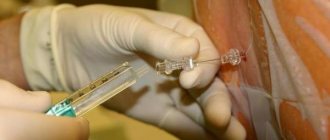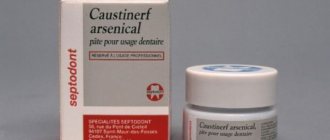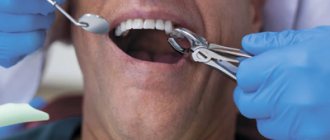What is carpule anesthesia?
Carpule anesthesia in dentistry is an injection anesthesia using a special syringe, which is called a carpule.
The use of a carpule syringe increases the safety and comfort of anesthesia.
That is, carpule anesthesia in dentistry can be of any type - the main thing is that a carpule syringe and the carpule itself with an anesthetic are used.
Storage rules and periods
Anesthesia solution is a medicinal product, so its storage conditions have special requirements.
Storage conditions:
- Optimum temperature 20-22C;
- Do not store in the refrigerator;
- A dark place, protected from direct sunlight;
- The shelf life is from 1 to 2 years.
Solutions that have expired are strictly prohibited from use. After a specified period, the properties of the active substance are lost.
In addition, various chemical reactions can occur in the solution, which make it toxic. Such anesthesia may not provide the desired analgesic effect and may also cause harm to health.
Signs of loss of drug properties
An anesthetic drug may become unusable not only due to expiration, but also due to non-compliance with storage conditions.
There are several signs that the drug has lost its properties and cannot be used:
- Damage to the integrity of the ampoule. Small cracks may occur due to improper transportation. Using carpules with defects can lead to their destruction at the time of injection;
- The solution has changed color or a precipitate has appeared. Ideally, the solution should be transparent. The appearance of impurities indicates a change in its chemical composition. This may occur due to the breakdown of the vasoconstrictor under the influence of heat;
- Presence of large bubbles. Small bubbles are always present in the solution due to the removal of oxygen during the manufacturing process.
If the ampoules are strongly cooled during storage or transportation, bubbles larger than 2 mm in size appear and the rubber stopper may even be slightly pushed out. Such ampoules must be returned to the manufacturer; - The appearance of rust on the carpule indicates a change in its chemical composition or an incorrect disinfection procedure.
If such signs are detected, it is strictly forbidden to use the carpule, since in addition to the lack of effect, an unexpected side effect may occur.
Stages of endodontic treatment of a tooth and the instruments used.
In this article, read what tasks are assigned to the electroodontometry procedure in dentistry.
Follow the link https://zubovv.ru/lechenie/zubyi/depoforeza-v-stomatologii-chto-eto.html to find out what depoforeza is.
Equipment
Essentially, a carpule syringe is a metal dental anesthesia syringe that can be used many times and is sterilized in the same way as other dental instruments. A carpule with an anesthetic is inserted into the carpule syringe - a special glass cartridge, factory-made.
Currently, the Trilogy Medical and Dental Center uses carpule syringes for injection anesthesia - they are much more convenient and more sophisticated than conventional disposable syringes.
Types of local anesthesia
Application anesthesia
This method completely eliminates the use of a needle and syringe. A small amount of a special anesthetic (paste, gel or ointment) is applied to the selected area with a cotton swab or fingers, which penetrates 2-3 millimeters into the soft tissue and blocks the nerve endings.
Application anesthesia
Since “freezing” acts for a short period of time (no more than 20 minutes), this method is more often used when performing simple and quick operations where it is necessary to anesthetize only the oral mucosa.
Application anesthesia is often used before the subsequent use of injection, especially if the patient is very afraid of injections, or when treating children.
The drug in aerosol form can also be used as an anesthetic. However, due to the complexity of calculating the required amount of anesthetic substance, this type has not been widely used in dentistry. The use of an aerosol increases the risk of complications, as it can easily penetrate the patient's respiratory tract and bloodstream.
Conduction anesthesia
This type of anesthesia is the most effective method in which the active substance is injected in small doses (no more than 5 milliliters in volume) using a special needle into a place located in close proximity to the nerve that controls the site of the intended intervention.
Conduction anesthesia
With this method, using only one dose of injection, you can achieve “freezing” not only of one tooth, but of a much larger area. To improve the effectiveness of the injected substance, the injection is given at an angle of 90 degrees. 15-20 minutes after the injection, the drug begins to act, and the doctor can begin manipulation.
The main advantage of using conduction anesthesia is the long duration of action of the drug - from one and a half to three hours. During this time, the doctor can work with several molars and adjacent soft tissues, perform a complex tooth extraction, perform surgery for a jaw injury, and much more. The duration of action of the drug can be increased by adding a dose of anesthetic if for some reason the duration of the operation has increased. Due to the fact that complete anesthesia occurs, the patient’s salivation decreases, which greatly simplifies the doctor’s work.
Infiltration anesthesia
In modern dentistry, this is one of the most common types of local anesthesia, in which the drug is administered with a syringe into the gum tissue. With this method, the nerve endings are blocked directly at the site where the anesthetic is injected. Currently, two methods of infiltration anesthesia are used: direct and indirect.
Infiltration anesthesia
Direct anesthesia - the medicine is directly injected under the mucous membrane in the place where dental procedures will be performed and the sensitivity of which needs to be reduced.
Indirect anesthesia - the active substance is injected at a distance of 2 centimeters or more from the site of manipulation, penetrates into the tissue and numbs a larger area.
The advantage of infiltration anesthesia is that after the administration of the anesthetic, in just a couple of minutes the doctor can begin work and the “freezing” effect lasts about an hour. This time is enough to perform implantation surgery, remove a tooth, treat pathological conditions of the gums and teeth, remove various tumors on the oral mucosa and other manipulations.
Depending on the area where the injection is given, infiltration anesthesia is:
- intraosseous (spongy) - the injection is placed directly into the bone between the roots of the teeth. It is most often used in the area of lower molars, during the treatment or extraction of teeth, when conduction and infiltration anesthesia are ineffective. This method allows for high-quality pain relief using a small amount (1-1.5 milliliters) of a weak anesthetic.
- intraligamentary (intraligamentous) - the anesthetic is administered with a special syringe under high pressure not into the nerve itself, but into the gum and jaw tissue, that is, into the periodontal space. Anesthesia occurs within a minute from the time of injection and lasts from 20 to 40 minutes. This is enough to perform outpatient procedures. This method of pain relief is low-traumatic, the drug accumulates to a greater extent in the injection area, so there is no gums during and after the injection.
- intracanal - performed using a drill. First, a hole is made in the tooth that matches the diameter of the needle, and then the anesthetic is injected directly into the pulp or deeper into the canal itself. Intracanal anesthesia is used as an adjunct to intraligamentary anesthesia.
Tuberal anesthesia
Tuberal anesthesia
When using this method, the anesthetic is injected into the tubercles of the upper jaw, which are called tuber in Latin. The posterior alveolar nerve is located in this area, thanks to which most of the alveolar ridge is “frozen”. The tuberal anesthesia method is rarely used, as it is considered dangerous from the point of view of the occurrence of various complications due to the individual structure of the jaw in this area and the location of nerves and blood vessels in it.
Advantages of carpule pain relief
The most important advantages of carpulal anesthesia can be considered:
- The exact amount of the drug in 1 ampoule is exactly 1.7 ml. Thanks to this, the doctor can count the carpules and know exactly the dosage of the administered drug.
- Complete sterility. Carpules are manufactured and sealed in a warehouse under completely sterile conditions. This way you can be sure of the quality of the injected drug.
- Less pain from the injection itself. Patients feel less pain when punctured because the needle of a carpule syringe is much thinner and more flexible than that of a regular syringe.
- It is more convenient for the doctor to control the process. The dental anesthesia carpule syringe fits very comfortably in the hand thanks to special handles and stops. Also due to the greater flexibility of the needle, it can be bent in almost any direction without fear of it breaking off.
- Elimination of errors. When using Carpules, the possibility that the doctor will administer the wrong drug or in the wrong quantity or concentration is completely eliminated. After all, with carpule anesthesia, the doctor always knows exactly what he is injecting - the name of the drug, its concentration and quantity is written on each carpule.
Syringe selection
When selecting a suitable syringe, the following important rules must be observed:
- When purchasing, you should take into account that most likely you will have to install needles from different manufacturers into the tool, so it is necessary that a spare clamp attachment is included with the device.
- The syringe must have the characteristics of convenience and aesthetic appeal (so as not to frighten patients).
- The body of the device must have increased strength, which allows the drug to be administered for pain relief under greater pressure.
- The dentist should use the syringe easily (with one hand).
- The device must be suitable for performing an aspiration test, which can prevent inadvertent injection of the substance into the blood vessels.
- When using the instrument on children, experts recommend purchasing auxiliary bright attachments for the device that disguise it, turning the therapy process into a game.
A reusable carpule syringe in dentistry manufactured by Anthogyr (France) is made of tool metal (steel) and often includes a spare clamp attachment. The product is characterized by ease of use and quality parameters.
Carpule syringes of the Asa Dental brand (Italy) are made of chrome-plated steel and are distinguished by a variety of models:
- number of rings;
- aspiration method;
- ergonomics and appearance;
- carpool fastening method.
Pakistani-made syringes (MEDENTA brand) are lower in cost compared to similar instruments produced in the European Union. The products are made from a particularly light alloy with a corrosion-resistant coating.
The design of the device provides for a large visibility window, which allows you to control the progress of aspiration. The model range includes a variety of products in appearance; there are various variations of replaceable tips.
Disadvantages of carpule anesthesia
Despite the minor disadvantages described below, carpule anesthesia in dentistry is currently considered the safest and most modern option for injecting an anesthetic.
- Higher price of equipment.
Carpule syringes are more expensive per unit than disposable syringes. This is due to the fact that syringes with carpules for anesthesia in dentistry are quite complex in design, plus really high-quality ones will cost more than simpler options.
- It is impossible to change the concentration of anesthetic inside the cartridge - the cartridge is completely sealed and it is not possible to add anything inside.
Reasons for the lack of pain relief
There are often cases when anesthesia may not work. There is a likely risk of a weak analgesic effect or its complete absence.
The reasons for this phenomenon can be called:
- Excessive fear. Many people are terrified of visiting the dentist.
In this case, a psychological factor is triggered - a person subconsciously feels pain. The action of adrenaline may occur, which blocks the nerve endings, and the active substance does not pass to them. In this situation, it is recommended to take a sedative a couple of hours before visiting the dentist. - Addictive effect. There are often cases when a person’s body adapts to the effects of painkillers and does not respond to them. In this case, it is necessary to change the type of active component.
- The effect of alcohol. Due to fear of visiting the dentist, some people may drink alcohol before visiting the doctor. Its action reduces the effectiveness of anesthesia. In such cases, it is necessary to increase the dose of the drug several times.
Conditions that local anesthetics must adhere to
In general, local anesthetics should:
- Do not cause allergies
- Have minimal toxicity to the body
- Have few side effects
- Easy to dissolve and excrete
In addition to this, anesthetic agents are required to:
- The effect is strong enough to completely anesthetize the tooth and surrounding tissues.
- Rapid numbness - no more than 5 minutes after the injection
- The numbness should last at least an hour - so that it is enough for the entire procedure, including the very last manipulations
- Anesthesia should take place no more than 2-3 hours later.
- Long-term stability of the drug itself – at least 2–3 years
Contents of the drug
Knowledge of the chemical composition is a prerequisite when using any product, and capsule painkillers cannot be considered an exception to this rule. Detailed information is provided on the packaging, and contains not only a list of names, but also the proportional presence of each component. The injector contains:
- An anesthetic is a substance that reduces the pain threshold to a minimum, making it possible to carry out medical manipulations in the problem area of the jaw. Such compounds belong to the category of amides and elements derived from them - examples usually include Lidocaine, articaine, prilocaine, etc.
- Vasoconstrictor is a stimulator of processes that constrict blood vessels and prolong the arrest of nerve endings. Increases the duration of the effect achieved as a result of the injection, and also prevents premature leaching from the working area. Provides for strict operating restrictions, and requires caution when used to treat patients suffering from chronic heart pathologies, diabetes, age-related changes, etc.
- Antioxidants – bisulfites and sodium sulfites, which prevent the destruction of the vasoconstrictor due to the influence of oxygen from the environment. They can provoke an allergic reaction, which also necessitates the patient undergoing preliminary diagnostics and studying the medical history.
- EDTA, parabens and preservatives are substances that ensure metal bonding, sterility of the capsule contents and preservation of the functional properties of the drug.
Thanks to this balanced composition, the anesthetic is reliably protected from the penetration of pathogenic microorganisms. The main requirement related to the specifics of the carpule anesthetic is to make sure before using the medication that the patient is not allergic to its derivatives and active components.
The best anesthetic – does it exist?
As we said above, almost all modern anesthetics are made on the basis of articaine, so there is not such a fundamental difference between them. Most patients are anesthetized with Ultracaine or Ubestezin.
But we must also take into account that, of course, it is important what is injected, but it is also important how it is done - a lot depends on the doctor and the technique of performing anesthesia.
Indications, contraindications and consequences of carpules anesthesia depend more on the type of anesthesia - infiltration or conduction, than specifically on the carpules. But, as we noted earlier, with carpule anesthesia there is no risk of administering the wrong drug and there is virtually no risk of the needle breaking off.
Flaws
The large list of advantages of this type of anesthesia does not exclude the presence of certain disadvantages.
The biggest disadvantage is the high cost of syringes. The production of such complex structures is expensive. The higher the quality of the tool, the higher its cost.
The second significant disadvantage of carpule anesthesia is the lack of possibility of modifying the used anesthetic with the help of a vasoconstrictor.
The ampoule with a solution of the substance is hermetically sealed and if opened, it will become unsuitable for use.
Feelings during conduction anesthesia
The first sign of the effects of conduction anesthesia is slight muscle numbness and a feeling of heaviness. In dentistry, drugs and doses are used that can numb the area in a matter of minutes.
Peripheral nerve blockade using conduction anesthesia is almost 100% safe. The risk of infection remains, but it is minimized in conditions of absolute sterility. Also, a hematoma may appear at the puncture site due to damage to the vessel. This most often happens when the patient takes drugs that reduce blood clotting.
After treatment, the feeling of numbness persists. Sensitivity will remain absent for some time (depending on the patient's response to the drug). Some people do not respond well to anesthesia, and pain may occur during the procedure. You need to notify the doctor, he will give an additional injection.
The duration of the effect is individual for each patient. Complete lack of sensitivity sometimes lasts for hours. The risk of nerve damage is less than one percent.
Central conduction anesthesia
Pterygopalatine anesthesia involves the injection of a solution into the pterygopalatine fossa. This fossa lies between the upper jaw and the pterygoid process of the sphenoid bone. It is safer to insert a needle into the pterygopalatine fossa than into the foramen rotundum.
Possible routes of pain relief
- palatine, when the needle is inserted through the greater palatine foramen and moved along the pterygopalatine canal, numbing the maxillary nerve;
- tuberous, when the solution is released near the maxillary tubercle and along the bone;
- orbital, when the skin above the bone of the anterior wall of the lower orbital margin is pierced, the solution is injected behind it;
- subzygomatic-pterygoid, when the needle is inserted into the middle of the trago-orbital line at the lower wall of the zygomatic arch, the anesthetic is injected into the outer plate of the pterygoid process, as well as into the pterygopalatine fossa.
Another method of central conduction anesthesia is anesthesia at the foramen ovale. It is located in the medial posterior part of the infratemporal fossa. The fossa itself is a depression on the side wall of the skull.
Methods for anesthetizing the foramen ovale
- subzygomatic, when a puncture is made in the middle of the trago-orbital line, deepened to the outer plate of the pterygoid process, through which they enter the foramen ovale;
- suprazygomatic, when the needle is inserted through the trago-orbital line, deviating downwards;
- mandibular, when the needle is passed along the inner surface of the branch, the end is retracted to the bone wall;
- orbital, when the lower edge of the orbit near the inferior outer corner is pierced, the needle penetrates the infratemporal fossa through the lateral region of the inferior orbital fissure.









